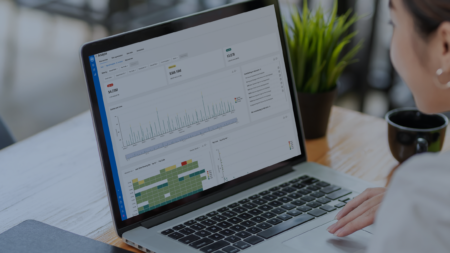Artificial intelligence is reshaping every corner of finance—and AI-powered decision intelligence tools now sit at the center of that transformation. From revenue protection to profit optimization, finance teams are using decision intelligence use cases to turn data into strategic action.
Far beyond dashboards and static reports, decision intelligence combines advanced analytics and AI to turn everyday financial data into clear, confident decisions. For CFOs and finance leaders, it’s the key to moving faster, staying ahead of risks, and driving measurable performance gains.
In this guide, you’ll discover seven real-world ways decision intelligence tools are helping finance teams elevate everything from revenue protection to profit optimization—and why this technology is quickly becoming essential for modern financial strategy.
1. General Ledger Analysis
General ledger analysis is foundational to auditing, making it a prime candidate for decision intelligence tools capable of processing entire datasets at once.
These can help internal auditors quickly detect unusual transactions, anomalies, and potential errors across massive datasets. Rather than sifting manually through ledgers, finance teams can use solutions like MindBridge AI to find actionable insights, saving substantial time and ensuring precise results.
For example, KPMG, a global leader with over 270,000 professionals, embedded MindBridge into its global smart audit platform to enhance audit quality and efficiency. By analyzing 100% of transactions, their teams shifted from sample-based testing to a risk-focused approach that drives deeper insights and stronger assurance.
2. Payroll Analysis
Payroll analysis uses decision intelligence to detect compliance issues and unusual patterns within your payroll data, protecting your organization from financial leakage and regulatory risk.
Advanced AI tools, like MindBridge, can identify ghost employees, unusual payment patterns, and policy violations that often slip through manual reviews. For finance teams struggling with labor-intensive payroll verification, these capabilities transform a week-long process into an efficient, reliable operation.
With decision intelligence tools, you can automate the detection process and dramatically reduce manual tasks, freeing your focus for higher-value work. For instance, SCG, a top-10 accounting firm in Ghana, faced audit bottlenecks and inefficiencies in payroll and financial risk assessments due to manual data analysis processes.
By adopting MindBridge’s AI-powered analytics, SCG automated payroll data reviews, accelerating risk detection, and improving compliance monitoring. The technology allowed finance teams to shift focus from tedious manual verification to identifying critical risks, ensuring more effective payroll oversight and stronger financial controls.
3. Vendor Analysis
Vendor analysis uses decision intelligence to safeguard against supplier-related risks such as duplicate payments, contract violations, and potentially fraudulent activities—areas of concern for CFOs and controllers alike.
Using automated analysis of vendor master data and payment histories, these tools help internal auditors flag irregularities early on, preventing financial losses. This proactive approach fosters better vendor relationships through fair treatment and prompt payments for all suppliers.
For instance, Chevron, one of the world’s largest energy companies, expanded its use of AI-powered analytics to vendor analysis, uncovering hidden financial risks within its procurement processes. With billions of financial and operational transactions across multiple ERPs and procurement systems, the company struggled to analyze its vast datasets.
Seeking a more proactive and scalable approach, Chevron implemented MindBridge AI’s anomaly detection and transaction risk analytics. With it, they were able to identify anomalies across millions of transactions, strengthening internal controls and preventing potential financial losses.
4. Travel & Expense Analysis
Travel and expense analysis is ideal for pinpointing wasteful spending and uncovering fraudulent expense claims.
Automated analysis of expense reports significantly reduces time spent by finance teams, providing precise and trustworthy results. AI can also help identify policy violations, wasteful spending, and potentially fraudulent claims that often hide within expense reports.
For CFOs and their teams, the benefits are immediate. Automated analysis replaces hours of manual receipt checking and policy verification, freeing up resources for higher-value work. More importantly, it creates a consistent, transparent approach to expense management that employees can trust.
5. Customer Analysis
Customer analysis applies decision intelligence to verify financial activities and ensure proper revenue recognition, helping organizations maintain financial integrity.
AI-driven decision intelligence helps internal auditors improve compliance, minimize revenue leakage, and ensure accurate revenue reporting. It also brings greater confidence in financial statements and improved accuracy in revenue reporting, all critical factors for maintaining stakeholder trust, while enabling CFOs to drive more strategic decisions grounded in clear revenue intelligence.
6. Joint Interest Billing (JIB) for Joint Ventures
In sectors like oil and gas, joint interest billing (JIB) presents unique auditing complexities. JIB analysis represents a specialized application of decision intelligence that ensures accurate cost allocation in complex joint ventures, particularly critical in the oil and gas industry.
JIB audits involve complex agreements, high transaction volumes, and multiple stakeholders, making manual validation daunting. Decision intelligence simplifies these challenges by automatically verifying calculations, reducing the potential for costly errors, and streamlining audit workflows.
However, to fully leverage AI in JIB analysis, auditors need to consider the specific factors that impact cost allocation. They include:
- Complex agreement structures with varying ownership percentages.
- High volume of transactions requiring consistent treatment.
- Multiple stakeholders with different accounting systems and expectations.
7. Continuous Margin Optimization
AI-powered decision intelligence doesn’t just prevent losses—it drives profit growth by uncovering margin improvement opportunities hidden in everyday transactions.
With MindBridge, finance and audit teams gain a holistic view of cash flow drivers, revenue leakage, and inefficiencies that erode profitability. Instead of reacting to historical variances, you can proactively optimize pricing, payment terms, and spending patterns in near real time.
Benefits of AI-Driven Profit Optimization
Here are five ways AI-powered decision intelligence drives higher profitability and unlocks continuous margin improvement:
Proactive Margin Expansion
MindBridge pinpoints where pricing, discounts, or supplier terms are eroding margins—so you can take action to protect profitability.
Revenue Leakage Prevention
From unbilled services to duplicate invoices, AI continuously monitors revenue streams to capture every dollar earned.
Accelerated Cash Conversion
Automated anomaly detection and validation workflows reduce time spent on reconciliations and corrections, freeing cash faster.
Data-Driven Performance Improvement
Instead of sampling or relying on intuition, your teams can optimize processes using objective, AI-generated insights across the entire transaction universe.
Seamless Integration with Existing Systems
MindBridge overlays your current finance and ERP tools to drive profit-focused performance—without disrupting established workflows.
As transaction volumes grow and market conditions shift faster than ever, finance teams can no longer rely on static reports. Decision intelligence brings continuous, AI-driven analysis to every corner of the organization—transforming data into decisions that protect revenue, optimize margins, and strengthen strategic resilience.
Embrace Decision Intelligence Today
AI-powered decision intelligence isn’t just a trend—it’s quickly becoming the foundation for modern finance. Whether you’re focused on reducing risk, accelerating cash flow, or maximizing profitability, these tools empower finance teams to move from reactive control to proactive strategy.
Explore how MindBridge’s AI-powered financial decision intelligence platform empowers finance leaders to detect risk, drive profitability, and make faster, smarter decisions across the enterprise.
FAQ: Decision Intelligence for Finance
What is decision intelligence in finance?
Decision intelligence applies AI and analytics to financial data to help CFOs and finance leaders make smarter, faster, and more confident decisions. It connects transaction-level details to strategic insights, enabling better risk management, forecasting, and profit optimization.
How is decision intelligence different from business intelligence?
Business intelligence shows you what happened; decision intelligence goes further by showing why it happened and what to do next. It combines AI, machine learning, and analytics to provide recommendations and automate next-best actions.
What are the top use cases for decision intelligence in finance?
Leading use cases include general ledger analysis, payroll compliance monitoring, vendor risk detection, travel and expense management, revenue assurance, joint venture billing, and continuous margin optimization.
How can finance teams get started with AI-powered decision intelligence?
Start with a focused use case that delivers fast ROI—like margin analysis or duplicate payment detection. Choose a platform purpose-built for finance that integrates easily with your existing ERP, and prioritize transparency and explainability.



